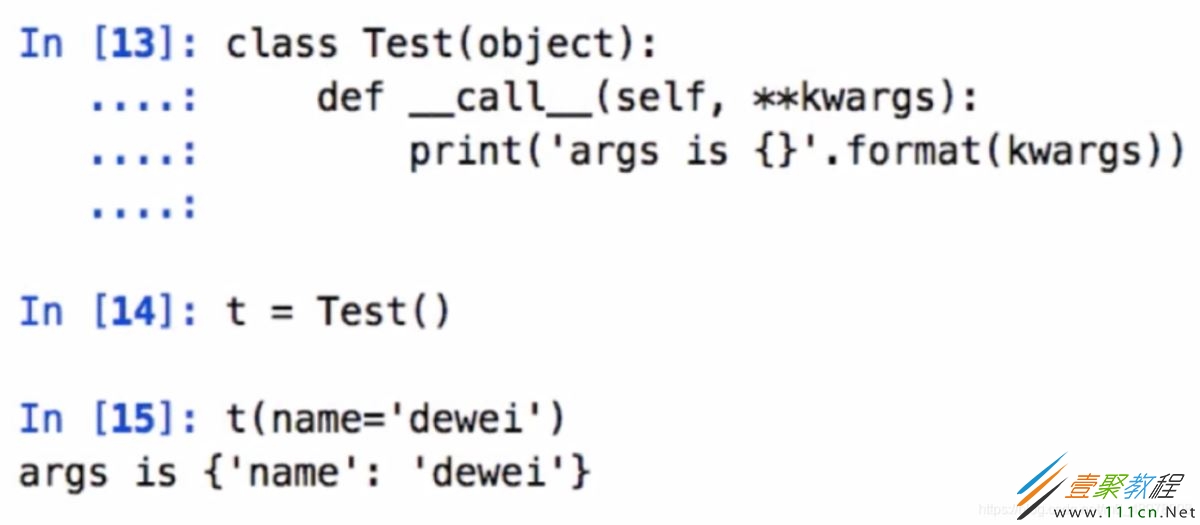Python类的高级函数代码示例解析
作者:袖梨
2022-06-25
本篇文章小编给大家分享一下Python类的高级函数代码示例解析,文章代码介绍的很详细,小编觉得挺不错的,现在分享给大家供大家参考,有需要的小伙伴们可以来看看。
__str__函数
如果定义了该函数,当print当前实例化对象的时候,会返回该函数的return信息
可用于定义当前类的描述信息
用法:
def __str__(self): return str_type
参数:无
返回值:一般返回对于该类的描述信息
__getattr__函数
当调用的属性或者方法不存在时,会返回该方法定义的信息
用法:
def __getattr__(self, key): print(something.….)
参数:
key: 调用任意不存在的属性名
返回值:
可以是任意类型也可以不进行返回
__setattr__函数
拦截当前类中不存在的属性与值
用法:
def __settattr__(self, key,value): self._dict_[key] = value
参数:
key当前的属性名
value 当前的参数对应的值
返回值: 无
__call__函数
本质是将一个类变成一个函数
用法:
def __call__(self,*args,**kwargs): print( 'call will start')
参数: 可传任意参数
返回值: 与函数情况相同可有可无
实战
#!/usr/bin/python3
# -*- coding: utf-8 -*-
# @Time : 2021/8/15 18:22
# @Author : InsaneLoafer
# @File : object_func.py
class Test(object):
def __str__(self):
return 'this is a test class'
def __getattr__(self, key):
return '这个key:{}并不存在'.format(key)
def __setattr__(self, key, value):
print(key, value)
self.__dict__[key] = value
print(self.__dict__)
def __call__(self, *args, **kwargs):
print('call will start')
print(args, kwargs)
t = Test()
print(t)
print(t.a) # 不存在的对象会直接打印出来,而不是报错
t.name = 'insane'
t(123, name='loafer')
"""实现链式操作"""
class Test2(object):
def __init__(self, attr=''):
self.__attr = attr
def __call__(self, name):
print('key is {}'.format(self.__attr))
return name
def __getattr__(self, key):
if self.__attr:
key = '{}.{}'.format(self.__attr, key)
else:
key = key
print(key)
return Test2(key) # 递归操作
t2 = Test2()
print(t2.a.c('insane'))
this is a test class
这个key:a并不存在
name insane
{'name': 'insane'}
call will start
(123,) {'name': 'loafer'}
a
a.c
key is a.c
insane
Process finished with exit code 0 相关文章
精彩推荐
-
 下载
下载我的世界国际版老版
模拟经营 我的世界国际版老版我的世界国际版正式版是一款拥有超高自由度玩法是沙盒手游,经典
-
 下载
下载我的世界国际版完整版
模拟经营 我的世界国际版完整版我的世界国际服完整版是一款十分经典好玩的mc沙盒类游戏,在海
-
 下载
下载摩托车销售模拟器内置菜单中文版
模拟经营 摩托车销售模拟器内置菜单中文版摩托车出售模拟器,又名摩托车销售模拟器,这是一个以摩托车销售
-
 下载
下载船舶模拟2020最新版
模拟经营 船舶模拟2020最新版船舶模拟2020是玩法非常有意思的模拟驾驶游戏,高清3d画质
-
 下载
下载油管主播的生活2内置菜单版
模拟经营 油管主播的生活2内置菜单版油管主播的生活2内置菜单版是一款模拟养成类游戏,在这里你将体



















